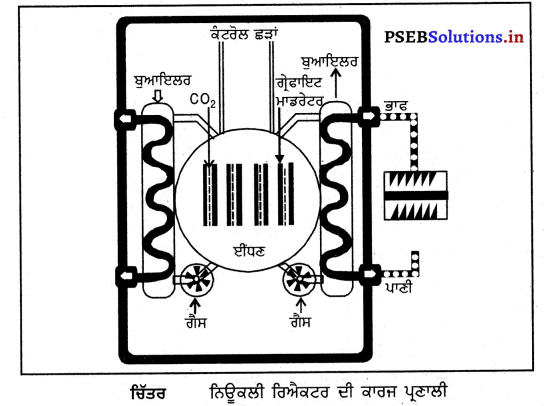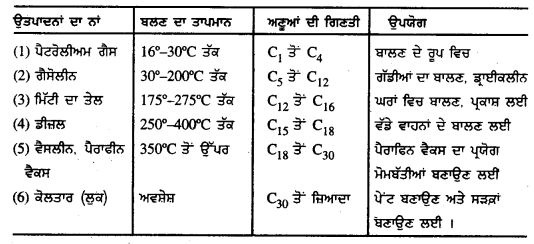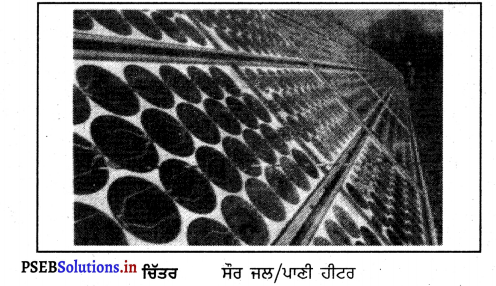Punjab State Board PSEB 11th Class Environmental Education Important Questions Chapter 13 ਊਰਜਾ ਦੇ ਗੈਰ ਰਵਾਇਤੀ ਸੋਤ Important Questions and Answers.
PSEB 11th Class Environmental Education Important Questions Chapter 13 ਊਰਜਾ ਦੇ ਗੈਰ ਰਵਾਇਤੀ ਸੋਤ
(ਓ) ਬਹੁਤ ਛੋਟੇ ਉੱਤਰਾਂ ਵਾਲੇ ਪ੍ਰਸ਼ਨ
ਪ੍ਰਸ਼ਨ 1.
ਅਲੱਗ-ਅਲੱਗ ਊਰਜਾ ਸਰੋਤਾਂ ਤੋਂ ਊਰਜਾ ਪ੍ਰਾਪਤ ਕਰਨ ਦੇ ਲਈ ਸਾਧਨ ਕੌਣ ਪ੍ਰਦਾਨ ਕਰਦਾ ਹੈ ?
ਉੱਤਰ-
ਤਕਨਾਲੋਜੀ
ਪ੍ਰਸ਼ਨ 2.
ਧਰਤੀ ਉੱਤੇ ਊਰਜਾ ਦਾ ਮੁੱਖ ਪ੍ਰਾਕ੍ਰਿਤਕ ਊਰਜਾ ਸ੍ਰੋਤ ਕੀ ਹੈ ?
ਉੱਤਰ-
ਸੂਰਜੀ ਊਰਜਾ।
ਪ੍ਰਸ਼ਨ 3.
ਕਿਸੇ ਦੋ ਪ੍ਰਾਕ੍ਰਿਤਕ ਊਰਜਾ ਸ੍ਰੋਤਾਂ ਦੇ ਨਾਂ ਲਿਖੋ ।
ਉੱਤਰ-
ਸੂਰਜੀ ਊਰਜਾ ਅਤੇ ਪੌਣ ਉਰਜਾ ।
ਪ੍ਰਸ਼ਨ 4.
ਸੂਰਜ ਵਿਚ ਊਰਜਾ ਦਾ ਸ੍ਰੋਤ ਕੀ ਹੈ ?
ਉੱਤਰ-
ਹਾਈਡੋਜਨ ਪ੍ਰਮਾਣੂਆਂ ਦੀ ਸੰਯੋਜਨ ਕਿਰਿਆ ।
ਪ੍ਰਸ਼ਨ 5.
ਸੂਰਜੀ ਤਾਪਕ ਦਾ ਮਾਨ ਕੀ ਹੈ ?
ਉੱਤਰ-
1.4 kJ/ms |
ਪ੍ਰਸ਼ਨ 6.
ਪੌਦੇ ਸੌਰ ਊਰਜਾ ਦਾ ਪ੍ਰਯੋਗ ਕਿਸ ਲਈ ਕਰਦੇ ਹਨ ?
ਉੱਤਰ-
ਪੌਦੇ ਸੌਰ ਊਰਜਾ ਦਾ ਪ੍ਰਯੋਗ ਪ੍ਰਕਾਸ਼ ਸੰਸ਼ਲੇਸ਼ਣ ਦੇ ਲਈ ਕਰਦੇ ਹਨ ।
![]()
ਪ੍ਰਸ਼ਨ 7.
ਪ੍ਰਕਾਸ਼ ਸੰਸ਼ਲੇਸ਼ਣ ਲਈ ਪੌਦੇ ਕਿਸ ਰੰਗ ਦਾ ਪ੍ਰਕਾਸ਼ ਸੋਖਦੇ ਹਨ ?
ਉੱਤਰ-
ਲਾਲ ਅਤੇ ਨੀਲੇ ਰੰਗ ਦਾ ਪ੍ਰਕਾਸ਼ ।
ਪ੍ਰਸ਼ਨ 8.
ਸੂਰਜ ਦੇ ਪ੍ਰਕਾਸ਼ ਦਾ ਕਿਹੜਾ ਘਟਕ ਵਸਤੂਆਂ ਨੂੰ ਗਰਮ ਕਰ ਦਿੰਦਾ ਹੈ ?
ਉੱਤਰ-
ਇਨਫਰਾਰੈੱਡ ਵਿਕਿਰਣ (Infrared Radiations) ।
ਪ੍ਰਸ਼ਨ 9.
ਭਾਰਤ ਦੇ ਕਿਹੜੇ ਦੋ ਪ੍ਰਮੁੱਖ ਸਥਾਨਾਂ ਤੇ ਪੌਣ ਚੱਕੀਆਂ ਨਾਲ ਬਿਜਲੀ ਪੈਦਾ ਕੀਤੀ ਜਾਂਦੀ ਹੈ ?
ਉੱਤਰ-
ਕੱਛ ਖੇਤਰ, ਤੁਤੀਕੋਰਿਨ ।
ਪ੍ਰਸ਼ਨ 10.
ਸਭ ਤੋਂ ਵੱਡੀ ਪ੍ਰਮਾਣੂ ਦੁਰਘਟਨਾ ਕਿਹੜੀ ਸੀ ?
ਉੱਤਰ-
ਚਰਨੋਬਾਇਲ ਪ੍ਰਮਾਣੂ ਕੇਂਦਰ ਦੁਰਘਟਨਾ ।
ਪ੍ਰਸ਼ਨ 11.
ਸੌਰ ਸੂਰਜੀ ਊਰਜਾ ਨਾਲ ਚੱਲਣ ਵਾਲੇ ਸੰਯੰਤਰਾਂ ਦੇ ਨਾਂ ਦੱਸੋ ।
ਉੱਤਰ-
ਸੂਰਜੀ ਕੁੱਕਰ, ਸੁਰਜੀ ਹੀਟਰ ।
ਪ੍ਰਸ਼ਨ 12.
ਬਾਇਓਗੈਸ ਵਿਚ ਕਿਹੜੀਆਂ-ਕਿਹੜੀਆਂ ਗੈਸਾਂ ਹੁੰਦੀਆਂ ਹਨ ?
ਉੱਤਰ-
ਮੀਥੇਨ, ਕਾਰਬਨ ਡਾਈਆਕਸਾਈਡ, ਹਾਈਡੋਜਨ, ਹਾਈਡੋਜਨ ਸਲਫਾਈਡ |
ਪ੍ਰਸ਼ਨ 13.
ਸੌਰ ਤਕਨਾਲੋਜੀ ਦਾ ਉਪਯੋਗ ਕਿਸ ਖੇਤਰ ਵਿਚ ਕੀਤਾ ਜਾਂਦਾ ਹੈ ?
ਉੱਤਰ-
ਸੌਰ ਪ੍ਰਯੋਗਿਕੀ ਦਾ ਉਪਯੋਗ ਉਪਹਿ, ਬਿਜਲੀ ਘੜੀਆਂ, ਕੈਲਕੁਲੇਟਰ, ਸਵੀਟ ਲਾਈਟਾਂ ਅਤੇ ਪਾਣੀ ਦੇ ਪੰਪਾਂ ਨੂੰ ਚਲਾਉਣ ਵਿਚ ਕੀਤਾ ਜਾਂਦਾ ਹੈ ।
![]()
ਪ੍ਰਸ਼ਨ 14
ਸਮੁੰਦਰੀ ਊਰਜਾ (Ocean Energy) ਦੇ ਦੋ ਰੂਪ ਦੱਸੋ ।
ਉੱਤਰ-
ਸਮੁੰਦਰੀ ਤਾਪ ਉਰਜਾ, ਜਵਾਰ-ਭਾਟਾ ਉਰਜਾ।
ਪ੍ਰਸ਼ਨ 15.
ਨਿਊਕਲੀਅਰ ਰੀਐਕਟਰ (Nuclear Reactor) ਦੇ ਮੁੱਖ ਭਾਗਾਂ ਦੇ ਨਾਂ ਦੱਸੋ !
ਉੱਤਰ-
ਰੀਐਕਟਰ ਕੋਰ, ਕੰਡੈਂਸਰ, ਜਨਰੇਟਰ, ਟਰਬਾਈਨ ।
ਪ੍ਰਸ਼ਨ 16.
ਯੂਰੇਨੀਅਮ (Uranium) ਦੀ ਕੱਚੀ ਧਾਤ ਭਾਰਤ ਦੇ ਕਿਹੜੇ ਖੇਤਰਾਂ ਵਿਚ ਉਪਲੱਬਧ ਹੈ ?
ਉੱਤਰ-
ਝਾਰਖੰਡ, ਆਂਧਰਾ ਪ੍ਰਦੇਸ਼, ਰਾਜਸਥਾਨ, ਹਿਮਾਲਿਆ ਖੇਤਰ ।
ਪ੍ਰਸ਼ਨ 17.
ਨਿਊਕਲੀਅਰ ਰੀਐਕਟਰ ਨੂੰ ਠੰਡਾ ਰੱਖਣ ਦੇ ਲਈ ਕਿਸ ਦਾ ਉਪਯੋਗ ਕੀਤਾ ਜਾਂਦਾ ਹੈ ?
ਉੱਤਰ-
ਭਾਰੀ ਪਾਣੀ (Heavy Water) ਦਾ।
ਪ੍ਰਸ਼ਨ 18.
ਯੂਰੇਨੀਅਮ ਦੀ ਕੱਚੀ ਧਾਤੂ ਨਾਲ ਈਂਧਨ ਕਿੱਥੇ ਬਣਾਈ ਜਾਂਦੀ ਹੈ ?
ਉੱਤਰ-
ਆਂਧਰਾ-ਪ੍ਰਦੇਸ਼ ਦੇ ਨਿਊਕਲੀਅਰ ਈਂਧਨ ਕੰਪਲੈਕਸ ਵਿਚ।
ਪ੍ਰਸ਼ਨ 19.
ਭਾਰਤ ਵਿਚ ਭਾਰੀ ਪਾਣੀ ਦਾ ਉਤਪਾਦਨ ਕਿੱਥੇ ਕੀਤਾ ਜਾਂਦਾ ਹੈ ?
ਉੱਤਰ-
ਕੋਟਾ, ਬੜੌਦਾ, ਤੁਤੀਕੋਰਨ, ਥਾਲ ਅਤੇ ਤਲਛੇਰ ।
ਪ੍ਰਸ਼ਨ 20.
ਬਾਇਓਗੈਸ ਵਿਚ ਮੀਥੇਨ ਦੀ ਮਾਤਰਾ ਕਿੰਨੀ ਹੁੰਦੀ ਹੈ ?
ਉੱਤਰ-
60-70% ।
ਪ੍ਰਸ਼ਨ 21.
ਪੌਣ ਫਾਰਮ (Wind Farm) ਕਿਹੜੇ ਖੇਤਰਾਂ ਵਿਚ ਸਥਾਪਿਤ ਕੀਤਾ ਜਾਂਦਾ ਹੈ ?
ਉੱਤਰ-
ਘਾਹ ਦੇ ਮੈਦਾਨ, ਪਹਾੜੀ ਖੇਤਰ, ਤੱਟੀ ਖੇਤਰ ਅਤੇ ਦੀਪ|
ਪ੍ਰਸ਼ਨ 22.
ਸਥਾਨਕ ਲੋਕ ਭੂ-ਤਾਪ ਊਰਜਾ ਦਾ ਉਪਯੋਗ ਕਿਨ੍ਹਾਂ ਗਤੀਵਿਧੀਆਂ ਦੇ ਲਈ ਕਰਦੇ ਹਨ ?
ਉੱਤਰ-
ਜਗਾ ਗਰਮ ਰੱਖਣ, ਖਾਣਾ ਬਣਾਉਣ, ਮੁਰਗੀ ਪਾਲਣ, ਖੁੰਭਾਂ ਦੀ ਖੇਤੀ ਅਤੇ ਭੋਜਨ ਦੀ ਪ੍ਰਕਿਰਿਆ ਦੇ ਲਈ ਸਥਾਨਿਕ ਲੋਕ ਭੂ-ਤਾਪ ਉਰਜਾ ਦਾ ਪ੍ਰਯੋਗ ਕਰਦੇ ਹਨ।
ਪ੍ਰਸ਼ਨ 23.
ਨਿਊਕਲੀ ਵਿਖੰਡਨ ਰੀਐਕਟਰ (Nuclear Fission Reactor) ਦਾ ਕੀ ਕਾਰਨ ਹੈ ?
ਉੱਤਰ-
ਨਿਊਕਲੀ ਵਿਖੰਡਨ ਰੀਐਕਟਰ ਦਾ ਕੰਮ ਨਿਊਕਲੀ ਊਰਜਾ ਨੂੰ ਕੰਟਰੋਲ ਵਿੱਚ ਰੱਖਣਾ ਹੈ ।
ਪ੍ਰਸ਼ਨ 24.
ਪਣ ਊਰਜਾ (Hydal Energy) ਤੋਂ ਕੀ ਭਾਵ ਹੈ ?
ਉੱਤਰ-
ਜਿਹੜੀ ਉਰਜਾ ਵਹਿੰਦੇ ਜਾਂ ਡਿੱਗਦੇ ਹੋਏ ਪਾਣੀ ਤੋਂ ਪ੍ਰਾਪਤੀ ਹੁੰਦੀ ਹੈ, ਉਸ ਨੂੰ ਪਣ ਉਰਜਾ ਕਹਿੰਦੇ ਹਨ ! ਪਣ ਉਰਜਾ ਨੂੰ ਪਣ ਸ਼ਕਤੀ ਵੀ ਆਖਿਆ ਜਾਂਦਾ ਹੈ ।
ਪ੍ਰਸ਼ਨ 25.
ਊਰਜਾ ਪ੍ਰਾਪਤ ਕਰਨ ਦੇ ਮੰਤਵ ਨਾਲ ਊਰਜਾ ਸੈੱਲ ਵਿਚ ਕਿਹੜੀ ਗੈਸ ਵਰਤੀ ਜਾਂਦੀ ਹੈ ?
ਉੱਤਰ-
ਹਾਈਡੋਜਨ ਗੈਸ ।
![]()
ਪ੍ਰਸ਼ਨ 26.
ਬਾਇਓਗੈਸ ਪਲਾਂਟ ਤੋਂ ਕੀ-ਕੀ ਪ੍ਰਾਪਤ ਕੀਤਾ ਜਾਂਦਾ ਹੈ ?
ਉੱਤਰ-
ਬਾਇਓਗੈਸ ਪਲਾਂਟ ਤੋਂ ਪ੍ਰਾਪਤ ਹੋਣ ਵਾਲੀਆਂ ਚੀਜ਼ਾਂ ਵਿੱਚ ਬਾਇਓਗੈਸ, ਕਾਰਬਨਿਕ ਖਾਦਾਂ, ਤਰਲ ਦੀ ਸਰੀ (Slurry) ਦੀ ਸ਼ਕਲ ਵਿਚ ਅਤੇ ਮੀਥੇਨ ਦੇ ਇਲਾਵਾ, ਈਥੇਨ ਅਤੇ ਕਾਰਬਨ-ਡਾਈਆਕਸਾਈਡ ਆਦਿ ।
ਪ੍ਰਸ਼ਨ 27.
ਬਿਜਲੀ ਦੀ ਵੰਡ ਸਮੇਂ ਕਿੰਨੇ ਪ੍ਰਤੀਸ਼ਤ ਬਿਜਲੀ ਜ਼ਾਇਆ ਹੁੰਦੀ ਹੈ ?
ਉੱਤਰ-
20%.
ਪ੍ਰਸ਼ਨ 28.
ਹਾਈਡੋਜਨ ਗੈਸ ਦੀ ਈਂਧਨ ਵਜੋਂ ਵਰਤੋਂ ਕਰਨ ਦੇ ਕੀ ਲਾਭ ਹਨ ?
ਉੱਤਰ-
ਹਾਈਡ੍ਰੋਜਨ ਦੀ ਈਂਧਨ ਵਜੋਂ ਵਰਤੋ ਕਰਨ ਨਾਲ
- ਪ੍ਰਦੂਸ਼ਣ ਨਹੀਂ ਫੈਲਦਾ ।
- ਹਾਈਡੋਜਨ ਦਾ ਕੈਲੋਰੀਮਾਨ ਬਹੁਤ ਜ਼ਿਆਦਾ ਹੈ ।
- ਹਾਈਡ੍ਰੋਜਨ ਇਕ ਨਿਪੁੰਨ ਈਂਧਨ ਹੈ ।
(ਅ) ਛੋਟੇ ਉੱਤਰਾਂ ਵਾਲੇ ਪ੍ਰਸ਼ਨ (Type I)
ਪ੍ਰਸ਼ਨ 1.
ਪਣ-ਊਰਜਾ ਯੋਜਨਾ ਦੇ ਲਾਭ ਲਿਖੋ ।
ਉੱਤਰ-
ਪਣ-ਊਰਜਾ ਯੋਜਨਾ ਦੇ ਹੇਠ ਲਿਖੇ ਲਾਭ ਹਨ
- ਇਹ ਬਿਜਲੀ ਪੈਦਾ ਕਰਨ ਦਾ ਸਸਤਾ ਸਾਧਨ ਹੈ।
- ਡੈਮਾਂ ਵਿਚੋਂ ਨਿਕਲਿਆ ਨਹਿਰਾਂ ਦਾ ਪਾਣੀ ਸਿੰਚਾਈ, ਉਦਯੋਗ ਅਤੇ ਪਾਣੀ ਪੂਰਤੀ ਲਈ ਵਰਤਿਆ ਜਾਂਦਾ ਹੈ।
- ਡੈਮ ਦੀ ਝੀਲ ਵਿਚ ਮੱਛੀ ਪਾਲਣ ਦਾ ਕੰਮ ਕੀਤਾ ਜਾਂਦਾ ਹੈ।
- ਡੈਮ ਦਾ ਨਿਰਮਾਣ ਹੜਾਂ ਅਤੇ ਸੋਕੇ ਨੂੰ ਵੀ ਕਾਬੂ ਕਰਦਾ ਹੈ।
ਪ੍ਰਸ਼ਨ 2.
ਸਾਗਰੀ ਊਰਜਾ ਦੀਆਂ ਹਾਨੀਆਂ ਲਿਖੋ ।
ਉੱਤਰ-
- ਸਾਰੀ ਤੁਫ਼ਾਨਾਂ ਨਾਲ ਬਿਜਲੀ ਨਸ਼ਟ ਹੋ ਜਾਂਦੀ ਹੈ।
- ਇਹ ਬਹੁਤ ਮਹਿੰਗਾ ਸਾਧਨ ਹੈ।
- ਇਸ ਨੂੰ ਪ੍ਰਾਪਤ ਕਰਨ ਨਾਲ ਸਾਗਰ ਵਿਚ ਰਹਿਣ ਵਾਲੇ ਜੀਵਾਂ ਦੀ ਗਿਣਤੀ ਘੱਟ ਜਾਂਦੀ ਹੈ।
ਪਸ਼ਨ 3.
ਧਰਤੀ ਦੀ ਤਾਪ ਉਰਜਾ ਤੋਂ ਕੀ ਭਾਵ ਹੈ ?
ਉੱਤਰ-
ਧਰਤੀ ਦੇ ਅੰਦਰ ਦੀ ਸੜਾ ਕਾਫ਼ੀ ਗਰਮ ਹੁੰਦੀ ਹੈ। ਇਸ ਵਿਚ ਚੱਟਾਨਾਂ ਮੈਗਮਾ ਦੇ ਰੂਪ ਵਿਚ ਪਾਈਆਂ ਜਾਂਦੀਆਂ ਹਨ। ਕਈ ਜਗਾ ਤੇ ਇਹ ਗਰਮ ਪਦਾਰਥ ਧਰਤੀ ਦੀ ਸਤਾ ਦੇ ਨੇੜੇ ਹੁੰਦੇ ਹਨ ਅਤੇ ਆਲੇ-ਦੁਆਲੇ ਦੇ ਧਰਤੀ ਦੇ ਪਾਣੀ ਨੂੰ ਭਾਫ਼ ਵਿਚ ਬਦਲ ਦਿੰਦੇ ਹਨ। ਇਹ ਭਾਫ਼ ਉੱਚ ਦਬਾਅ ਵਾਲੀ ਹੁੰਦੀ ਹੈ। ਇਸ ਦੇ ਨਾਲ ਬਿਜਲੀ ਪੈਦਾ ਹੋ ਸਕਦੀ ਹੈ। ਇਸ ਤਰ੍ਹਾਂ ਦੀ ਧਰਤੀ ਦੇ ਅੰਦਰ ਪਾਈ ਜਾਣ ਵਾਲੀ ਗਰਮੀ ਨੂੰ ਧਰਤੀ ਦੀ ਤਾਪ ਊਰਜਾ ਕਹਿੰਦੇ ਹਨ।
ਪ੍ਰਸ਼ਨ 4.
ਜਵਾਰਭਾਟਾ ਊਰਜਾ ਕੀ ਹੁੰਦੀ ਹੈ ?
ਉੱਤਰ-
ਜਵਾਰਭਾਟਾ ਊਰਜਾ ਸਾਗਰ ਤੋਂ ਪ੍ਰਾਪਤ ਹੋਣ ਵਾਲੀ ਉਰਜਾ ਹੈ। ਚੰਦਰਮਾ ਅਤੇ ਸੂਰਜ ਦੀ ਗੁਰੁਤਾਕਰਸ਼ਣ ਤਾਕਤ ਕਾਰਨ ਸਮੁੰਦਰ ਦਾ ਪਾਣੀ ਉੱਪਰ ਚੜ੍ਹਦਾ ਹੈ ਅਤੇ ਹੇਠਾਂ ਉਤਰਦਾ ਹੈ। ਇਨ੍ਹਾਂ ਲਹਿਰਾਂ ਨੂੰ ਜਵਾਰਭਾਟਾ ਆਖਦੇ ਹਨ। ਇਸ ਦੀ ਊਰਜਾ ਨੂੰ ਜਵਾਰਭਾਟਾ ਉਰਜਾ ਕਿਹਾ ਜਾਂਦਾ ਹੈ। ਜਦੋਂ ਇਹ ਲਹਿਰਾਂ ਆਪਣੀ ਔਸਤ ਤੋਂ 50 ਤੋਂ 100 ਗੁਣਾਂ ਉੱਪਰ ਉਠਦੀਆਂ ਹਨ ਤਾਂ ਇਸ ਨਾਲ ਟਰਬਾਈਨ ਚਲਾ ਕੇ ਇਸ ਤੋਂ ਬਿਜਲੀ ਪ੍ਰਾਪਤ ਕੀਤੀ ਜਾਂਦੀ ਹੈ। ਜਵਾਰਭਾਟਾ ਊਰਜਾ ਦਾ ਇਕ ਚੰਗਾ, ਨਵਿਆਉਣਯੋਗ ਪਰ ਮਹਿੰਗਾ ਊਰਜਾ ਸ੍ਰੋਤ ਹੈ।
ਪ੍ਰਸ਼ਨ 5.
ਨਿਊਕਲੀਅਰ ਰੀਐਕਟਰ ਦੀ ਕਾਰਜ ਪ੍ਰਣਾਲੀ ਦਾ ਵਰਣਨ ਕਰੋ ।
ਉੱਤਰ-
ਨਿਊਕਲੀਅਰ ਰੀਐਕਟਰ ਨਿਊਕਲੀਅਰ ਕਿਰਿਆ ਨੂੰ ਨਿਯੰਤਰਨ ਵਿਚ ਰੱਖਦਾ ਹੈ। ਰੀਐਕਟਰ ਕੋਰ ਵਿਚ ਯੂਰੇਨੀਅਮ ਰੱਖਿਆ ਜਾਂਦਾ ਹੈ ਜੋ ਵਿਖੰਡਨ ਕਰਦਾ ਹੈ। ਇਹ ਨਿਯੰਤਰਨ ਸਪੈਸ਼ਲ ਕਿਸਮ ਦੀਆਂ ਛੜਾਂ ਨਾਲ ਹੁੰਦਾ ਹੈ। ਇਹ ਛੜਾਂ ਵਿਖੰਡਨ ਦੇ ਦੌਰਾਨ ਵੀ ਨਿਊਟਰੋਨਾਂ ਨੂੰ ਕੰਟਰੋਲ ਕਰਦੀਆਂ ਹਨ। ਵਿਖੰਡਣ ਵਿਚ ਪੈਦਾ ਹੋਈ ਊਰਜਾ ਵਾਸ਼ਪੀਕਰਨ ਕਰਦੀ ਹੈ। ਇਨ੍ਹਾਂ ਵਾਸ਼ਪਾਂ ਦਾ ਪ੍ਰਯੋਗ ਜਨਰੇਟਰ ਦੀ ਟਰਬਾਈਨ ਮਾਉਣ ਲਈ ਕੀਤਾ ਜਾਂਦਾ ਹੈ ਅਤੇ ਇਹ ਬਿਜਲੀ ਪੈਦਾ ਕਰਨ ਲਈ ਵਰਤਿਆ ਜਾਂਦਾ ਹੈ।

ਪ੍ਰਸ਼ਨ 6.
ਭਾਰਤ ਦੇ ਪ੍ਰਮਾਣੂ ਸ਼ਕਤੀ ਕੇਂਦਰਾਂ ਦੇ ਨਾਂ ਲਿਖੋ ।
ਉੱਤਰ-
- ਤਾਰਾਪੁਰ ਪ੍ਰਮਾਣੂ ਸ਼ਕਤੀ ਕੇਂਦਰ (ਮਹਾਂਰਾਸ਼ਟਰ) ।
- ਰਾਜਸਥਾਨ ਪ੍ਰਮਾਣੂ ਸ਼ਕਤੀ ਕੇਂਦਰ ।
- ਨਰੋਰਾ ਪ੍ਰਮਾਣੂ ਸ਼ਕਤੀ ਕੇਂਦਰ (ਉੱਤਰ ਪ੍ਰਦੇਸ਼) ।
ਪ੍ਰਸ਼ਨ 7.
ਨਿਊਕਲੀਅਰ ਊਰਜਾ (Nuclear Energy) ਦੇ ਲਾਭ ਲਿਖੋ।
ਉੱਤਰ-
ਨਿਊਕਲੀਅਰ ਊਰਜਾ ਪੈਦਾ ਹੋਣ ਸਮੇਂ ਹੋਰ ਬਾਲਣਾਂ ਦੀ ਤਰ੍ਹਾਂ ਵਾਯੂ. ਪ੍ਰਦੂਸ਼ਕ ਜਿਵੇਂ-ਕਾਰਬਨਡਾਈਆਕਸਾਈਡ, ਸਲਫਰਡਾਈਆਕਸਾਈਡ ਅਤੇ ਨਾਈਟ੍ਰੋਜਨ ਦੇ ਆਕਸਾਈਡ ਪੈਦਾ ਨਹੀਂ ਹੁੰਦੇ। ਇਸ ਤੋਂ ਇਲਾਵਾ ਇਸ ਨਾਲ ਲਟਕਦੇ ਕਣ ਪੈਦਾ ਨਹੀਂ ਹੁੰਦੇ। ਇਹ ਉਰਜਾ ਉੱਚੇ ਸਤਰ ਦੀ ਉਰਜਾ ਹੈ ਅਤੇ ਸੰਘਣੀ ਉਰਜਾ ਦਾ ਸ੍ਰੋਤ ਹੈ।
![]()
ਪ੍ਰਸ਼ਨ 8.
ਜੀਵ-ਪੁੰਜ ਊਰਜਾ (Biomass Energy) ਦਾ ਉਪਯੋਗ ਕਿਸ ਤਰ੍ਹਾਂ ਵਾਯੂ ਪ੍ਰਦੂਸ਼ਣ ਪੈਦਾ ਕਰਦਾ ਹੈ ?
ਉੱਤਰ-
ਜੀਵ-ਪੁੰਜ ਦੇ ਜਲਣ ਨਾਲ ਕਾਰਬਨ ਡਾਈਆਕਸਾਈਡ ਪੈਦਾ ਹੁੰਦੀ ਹੈ। ਇਸਦੇ ਹੋਰ ਰੂਪ ਜਿਵੇਂ- ਮਲ-ਮੂਤਰ, ਫ਼ਸਲ ਦਾ ਬਚਿਆ-ਖੁਚਿਆ ਹਿੱਸਾ ਆਦਿ ਦੇ ਰੂਪ ਵਿਚ ਪ੍ਰਯੋਗ ਦੇ ਦੌਰਾਨ ਵਾਯੂ-ਮੰਡਲ ਵਿਚ ਸਲਫਰ ਅਤੇ ਨਾਈਟ੍ਰੋਜਨ ਦੇ ਆਕਸਾਈਡਾਂ ਦੀ ਮਾਤਰਾ ਵੱਧ ਜਾਂਦੀ ਹੈ। ਇਸ ਤੋਂ ਇਲਾਵਾ ਹੋਰ ਹਵਾ ਵਿਚ ਲਟਕਦੇ ਹੋਏ ਧੂੜ ਦੇ ਕਣ ਪੈਦਾ ਹੁੰਦੇ ਹਨ। ਇਨ੍ਹਾਂ ਸਾਰਿਆਂ ਦੇ ਕਾਰਨ ਵਾਯੂ ਪ੍ਰਦੂਸ਼ਣ ਪੈਦਾ ਹੁੰਦਾ ਹੈ। ਕਾਰਬਨਡਾਈਆਕਸਾਈਡ ਦੀ ਮਾਤਰਾ ਵੱਧਣ ਕਾਰਨ ਧਰਤੀ ਦੇ ਤਾਪਮਾਨ ਦੇ ਵਾਧੇ ਦੀ ਸਮੱਸਿਆ ਵਿਚ ਵਾਧਾ ਹੁੰਦਾ ਹੈ।
ਪ੍ਰਸ਼ਨ 9.
ਵਿਸ਼ਵ ਦਾ ਸਭ ਤੋਂ ਵੱਡਾ ਸੂਰਜੀ ਭਾਫ਼ ਯੰਤਰ ਕਿੱਥੇ ਹੈ ? ਇਸ ਦੇ ਉਤਪਾਦਨ ਦੇ ਬਾਰੇ ਲਿਖੋ ।
ਉੱਤਰ-
ਵਿਸ਼ਵ ਦਾ ਸਭ ਤੋਂ ਵੱਡਾ ਸੁਰਜੀ ਭਾਫ਼ ਯੰਤਰ ਰਾਜਸਥਾਨ ਵਿਚ ਮਾਉਂਟ ਆਬੂ ਦੇ ਨਾਲ ਤਲੇਟੀ ਤੇ ਸਥਾਪਿਤ ਹੈ। ਇਹ ਭੋਜਨ ਪਕਾਉਣ ਦਾ ਸਭ ਤੋਂ ਵੱਡਾ ਯੰਤਰ ਹੈ। ਇਸ ਵਿਚ 10,000 ਲੋਕਾਂ ਦਾ ਭੋਜਨ ਅਤੇ ਲਗਪਗ 4000 ਕਿਲੋਗ੍ਰਾਮ ਭਾਫ਼ ਬਣਦੀ ਹੈ। ਇਸ ਵਿਚ 300 ਲਿਟਰ ਪਾਣੀ ਪਾਉਣ ਦੀ ਵਿਵਸਥਾ ਹੈ।
ਪ੍ਰਸ਼ਨ 10.
ਊਰਜਾ ਦੇ ਗੈਰ-ਰਵਾਇਤੀ ਸ੍ਰੋਤਾਂ ਤੇ ਨੋਟ ਲਿਖੋ।
ਉੱਤਰ-
ਊਰਜਾ ਦੇ ਗੈਰ-ਰਵਾਇਤੀ ਲੋੜਾਂ ਨੂੰ ਨਵਿਆਉਣਯੋਗ ਊਰਜਾ ਸੋਤ ਵੀ ਕਿਹਾ ਜਾਂਦਾ ਹੈ। ਇਹ ਸੋਤ ਉਰਜਾ ਦੇ ਅਸੀਮਿਤ ਭੰਡਾਰ ਹਨ। ਇਸ ਲਈ ਇਨ੍ਹਾਂ ਦਾ ਲਗਾਤਾਰ ਉਪਯੋਗ ਕਰਦੇ ਰਹਿਣ ਨਾਲ ਵੀ ਇਹ ਖ਼ਤਮ ਨਹੀਂ ਹੁੰਦੇ। ਇਹ ਸੋਤ ਵਾਤਾਵਰਣ ਦੇ ਅਨੁਕੂਲ ਹਨ। ਇਨ੍ਹਾਂ ਨਾਲ ਪ੍ਰਦੂਸ਼ਣ ਵੀ ਨਹੀਂ ਫੈਲਦਾ। ਇਸ ਲਈ ਇਹ ਕੁਦਰਤ ਦੇ ਮਿੱਤਰ ਹਨ। ਇਨ੍ਹਾਂ ਊਰਜਾ ਸੋਤਾਂ ਨੂੰ ਕੁਦਰਤੀ ਊਰਜਾ ਸ੍ਰੋਤ ਵੀ ਕਿਹਾ ਜਾਂਦਾ ਹੈ ਕਿਉਂਕਿ ਉਨ੍ਹਾਂ ਵਿਚ ਊਰਜਾ ਕੁਦਰਤ ਦੇ ਹਿਸਾਬ ਦੇ ਨਾਲ ਵਿਕਸਿਤ ਹੁੰਦੀ ਹੈ। ਇਨ੍ਹਾਂ ਦੇ ਪ੍ਰਮੁੱਖ ਰੂਪ ਹਨ-ਸੂਰਜੀ ਊਰਜਾ, ਪੌਣ ਊਰਜਾ, ਜਵਾਰਭਾਟੀ ਊਰਜਾ, ਧਰਤੀ ਦੀ ਤਾਪ ਊਰਜਾ, ਜੀਵ ਊਰਜਾ ਆਦਿ।
(ੲ) ਛੋਟੇ ਉੱਤਰਾਂ ਵਾਲੇ ਨ (Type II)
ਪ੍ਰਸ਼ਨ 1.
ਭੂ-ਤਾਪ ਊਰਜਾ (Geothermal Energy) ਦੇ ਲਾਭ ਅਤੇ ਸੀਮਾਵਾਂ ਦੱਸੋ।
ਉੱਤਰ-
ਧਰਤੀ ਦੇ ਅੰਦਰ ਦੀ ਉਰਜਾ ਨੂੰ ਭੂ-ਤਾਪ ਉਰਜਾ ਕਿਹਾ ਜਾਂਦਾ ਹੈ। ਭੂ-ਤਾਪ ਊਰਜਾ ਦੇ ਕਾਰਨ ਉਤਪੰਨ ਹੋਈ ਭਾਫ਼ ਦੀ ਮੱਦਦ ਨਾਲ ਬਿਜਲੀ ਪੈਦਾ ਕੀਤੀ ਜਾਂਦੀ ਹੈ। ਇਸ ਤੋਂ ਇਲਾਵਾ ਭੂ-ਤਾਪ ਉਰਜਾ ਦੇ ਬਣੇ ਗਰਮ ਪਾਣੀ ਦੇ ਚਸ਼ਮੇ ਦਾ ਉਪਯੋਗ ਆਦਮੀ ਖਾਣਾ ਬਣਾਉਣ, ਨਹਾਉਣ ਲਈ ਕਰਦੇ ਹਨ। ਭੂ-ਤਾਪ ਊਰਜਾ ਦੇ ਲਾਭ (Advantages)-
- ਇਹ ਇਕ ਸਥਿਰ ਊਰਜਾ ਸ੍ਰੋਤ ਹੈ। ਇਸ ਦੇ ਨਾਲ ਬਿਜਲੀ ਯੰਤਰ ਸਾਰਾ ਸਾਲ ਲਗਾਤਾਰ 24 ਘੰਟੇ ਚਲਦਾ ਹੈ।
- ਇਹ ਪ੍ਰਦੂਸ਼ਣ ਰਹਿਤ ਹੈ।
- ਇਸ ਵਿਚ ਕੋਈ ਬਾਲਣ ਯੋਗ ਨਹੀਂ ਹੁੰਦਾ, ਇਹ ਬਿਜਲੀ ਬਣਾਉਣ ਦਾ ਸਸਤਾ ਸਾਧਨ ਹੈ।
ਭੂ-ਤਾਪ ਉਰਜਾ ਦੀਆਂ ਹਾਨੀਆਂ (Limitaitons)-ਚੱਟਾਨਾਂ ਵਿਚ ਛੇਕ ਕਰਕੇ ਭਾਫ਼ ਬਾਹਰ ਕੱਢਣਾ ਇਕ ਔਖਾ ਕੰਮ ਹੈ। ਇਸ ਤੋਂ ਲਾਵਾ ਬਾਹਰ ਨਿਕਲਣ ਦਾ ਵੀ ਡਰ ਹੁੰਦਾ ਹੈ।
ਪ੍ਰਸ਼ਨ 2.
ਸਾਗਰੀ ਤਾਪ ਊਰਜਾ (Oceanic Thermal Energy) ਤੇ ਨੋਟ ਲਿਖੋ ।
ਉੱਤਰ-
ਸਾਗਰੀ ਤਾਪ ਊਰਜਾ, ਸਾਗਰ ਵਿਚੋਂ ਉਰਜਾ ਪ੍ਰਾਪਤ ਕਰਨ ਦੀ ਵਿਧੀ ਹੈ। ਸੂਰਜ ਦੀ ਗਰਮੀ ਨਾਲ ਸਮੁੰਦਰ ਦੀ ਪਰਤ ਦਾ ਪਾਣੀ ਕਾਫ਼ੀ ਗਰਮ ਹੋ ਜਾਂਦਾ ਹੈ। ਜਦੋਂ ਕਿ ਸਮੁੰਦਰ ਦੀ ਗਹਿਰਾਈ ਦਾ ਪਾਣੀ ਠੰਡਾ ਰਹਿੰਦਾ ਹੈ। ਗਰਮ ਅਤੇ ਠੰਢੇ ਪਾਣੀ ਵਿਚ ਪੈਦਾ ਹੋਏ ਤਾਪ ਦੇ ਅੰਤਰ ਨੂੰ ਊਰਜਾ ਦਾ ਸੋਮਾ ਕਿਹਾ ਜਾਂਦਾ ਹੈ। ਇਹ ਊਰਜਾ ਸਾਗਰੀ ਤਾਪ ਊਰਜਾ ਅਖਵਾਉਂਦੀ ਹੈ। ਇਸ ਵਿਚ ਬਿਜਲੀ ਪ੍ਰਾਪਤ ਕਰਨ ਲਈ ਠੰਡੇ ਅਤੇ ਗਰਮ ਪਾਣੀ ਵਿਚ ਅੰਤਰ 20°C ਜਾਂ ਇਸ ਤੋਂ ਜ਼ਿਆਦਾ ਹੋਣਾ ਚਾਹੀਦਾ ਹੈ।
ਸਾਗਰੀ ਤਾਪ ਊਰਜਾ ਰੂਪਾਂਤਰ ਯੰਤਰ ਵਿਚ ਸਾਗਰੀ ਪਾਣੀ ਦੀ ਤਾਪ ਊਰਜਾ ਦਾ ਉਪਯੋਗ ਬਿਜਲੀ ਪੈਦਾ ਕਰਨ ਲਈ ਕੀਤਾ ਜਾਂਦਾ ਹੈ। ਸਮੁੰਦਰ ਦੀ ਉੱਪਰ ਵਾਲੀ ਸੜਾ ਵਿਚ ਪਾਣੀ ਦੀ ਉਰਜਾ ਤੋਂ ਅਮੋਨੀਆ ਵਰਗੇ ਤਰਲ ਨੂੰ ਉਬਾਲਿਆ ਜਾਂਦਾ ਹੈ। ਇਸ ਤੋਂ ਪੈਦਾ ਹੋਣ ਵਾਲੀ ਭਾਫ਼ ਨੂੰ ਟਰਬਾਈਨ ਚਲਾ ਕੇ ਬਿਜਲੀ ਪੈਦਾ ਕੀਤੀ ਜਾ ਸਕਦੀ ਹੈ। ਸਮੁੰਦਰ ਦੀ ਗਹਿਰਾਈ ਤੋਂ ਠੰਡੇ ਪਾਣੀ ਨੂੰ ਪੰਪ ਦੀ ਸਹਾਇਤਾ ਨਾਲ ਉੱਪਰ ਖਿੱਚਿਆ ਜਾਂਦਾ ਹੈ, ਭਾਫ਼ ਨੂੰ ਠੰਡਾ ਕਰਕੇ ਅਮੋਨੀਆ ਨੂੰ ਫਿਰ ਤਰਲ ਵਿਚ ਬਦਲ ਦਿੱਤਾ ਜਾਂਦਾ ਹੈ। ਇਸ ਤਰ੍ਹਾਂ ਇਹ ਕਿਰਿਆ ਲਗਾਤਾਰ ਚਲਦੀ ਹੈ। ਸਾਗਰੀ ਤਾਪ ਉਰਜਾ ਨਵਿਆਉਣਯੋਗ ਊਰਜਾ ਸੋਮਾ ਹੈ। ਇਹ ਵਾਤਾਵਰਣ ਲਈ ਠੀਕ ਹੈ, ਪਰ ਇਸ ਨੂੰ ਵਰਤਣ ਲਈ ਉੱਨਤ ਸਾਧਨਾਂ ਦੀ ਜ਼ਰੂਰਤ ਹੈ।
ਪ੍ਰਸ਼ਨ 3.
ਨਿਊਕਲੀਅਰ ਊਰਜਾ (Nuclear Energy) ਦੀਆਂ ਕਮੀਆਂ ਲਿਖੋ ।
ਉੱਤਰ-
ਨਿਊਕਲੀਅਰ ਊਰਜਾ ਦੀਆਂ ਸੀਮਾਵਾਂ ਹੇਠ ਲਿਖੀਆਂ ਹਨ –
- ਇਸ ਊਰਜਾ ਨੂੰ ਪ੍ਰਾਪਤ ਕਰਨ ਲਈ ਉੱਚ ਕੋਟੀ ਦੇ ਯੂਰੇਨੀਅਮ ਨੂੰ ਆਯਾਤ ਕਰਨਾ ਪੈਂਦਾ ਹੈ।
- ਨਿਊਕਲੀਅਰ ਰੀਐਕਟਰ ਵਿਚ ਪੈਦਾ ਹੋਇਆ ਕਚਰਾ ਬੜਾ ਹਾਨੀਕਾਰਕ ਹੁੰਦਾ ਹੈ। ਇਸ ਦੇ ਕਾਰਨ ਦੁਰਘਟਨਾ ਦਾ ਖ਼ਤਰਾ ਬਣਿਆ ਰਹਿੰਦਾ ਹੈ।
- ਰੇਡੀਓ ਵਿਕਿਰਣਾਂ ਆਦਮੀ ਦੀ ਸਿਹਤ ਅਤੇ ਵਾਤਾਵਰਣ ‘ਤੇ ਬੁਰਾ ਅਸਰ ਪਾਉਂਦੀਆਂ ਹਨ। ਇਸ ਕਾਰਨ ਆਦਮੀ ਵਿਚ ਜੀਨ ਸੰਬੰਧੀ ਸਮੱਸਿਆਵਾਂ ਆ ਸਕਦੀਆਂ ਹਨ ।
- ਰੇਡੀਓ ਵਿਕਿਰਣਾਂ ਦੇ ਫਾਲਤੂ ਦੇ ਪ੍ਰਬੰਧ ਲਈ, ਸੁਰੱਖਿਆ ਦੇ ਪ੍ਰਬੰਧ ਅਤੇ ਰੀਐਕਟਰ ਦੇ ਨਿਰਮਾਣ ਲਈ ਭਾਰੀ ਖ਼ਰਚੇ ਦੀ ਜ਼ਰੂਰਤ ਹੈ।
(ਸ) ਵੱਡੇ ਉੱਤਰਾਂ ਵਾਲੇ ਪ੍ਰਸ਼ਨ –
ਪ੍ਰਸ਼ਨ 1.
ਗੋਬਰ ਗੈਸ (ਬਾਇਓਗੈਸ) ਦੇ ਨਿਰਮਾਣ, ਲਾਭ ਅਤੇ ਹਾਨੀਆਂ ਤੇ ਟਿੱਪਣੀ ‘ ਲਿਖੋ।
ਉੱਤਰ-
ਬਾਇਓਗੈਸ ਜਾਂ ਗੋਬਰ ਗੈਸ ਦਾ ਉਤਪਾਦਨ ਸੂਖ਼ਮ ਜੀਵਾਂ ਦੁਆਰਾ ਕੀਤੀ ਗਈ ਕਿਰਿਆ ਦੇ ਕਾਰਨ ਹੁੰਦਾ ਹੈ। ਬਾਇਓਗੈਸ ਬਣਾਉਣ ਲਈ ਪਸ਼ੂਆਂ ਦਾ ਗੋਹਾ ਅਤੇ ਝੜੇ ਹੋਏ ਸੁੱਕੇ ਪੱਤਿਆਂ ਨੂੰ ਹਵਾ ਤੋਂ ਬਿਨਾਂ ਵਾਤਾਵਰਣ ਵਿਚ ਅਤੇ ਪਾਣੀ ਵਿਚ ਰੱਖਿਆ ਜਾਂਦਾ ਹੈ। ਅਣ ਆਕਸ਼ੀ ਜਿਸ ਥਾਂ ਵਿੱਚ ਇਸ ਘੋਲ ਨੂੰ ਰੱਖਿਆ ਜਾਂਦਾ ਹੈ ਉਸ ਨੂੰ ਚੁਸ (Digester) ਆਖਦੇ ਹਨ । ਸੂਖ਼ਮ ਜੀਵਾਂ ਦੁਆਰਾ ਕੀਤੀ ਗਈ ਕਿਰਿਆ ਵਿਚ ਇਹ ਇਕ ਮਿਸ਼ਰਣ ਤੋਂ ਮੀਥੇਨ, ਹਾਈਡੋਜਨ, ਕਾਰਬਨਡਾਈਆਕਸਾਈਡ ਅਤੇ ਹਾਈਡਰੋਜਨ ਸਲਫਾਈਡ ਆਦਿ ਗੈਸਾਂ ਪੈਦਾ ਹੁੰਦੀਆਂ ਹਨ।
ਇਨ੍ਹਾਂ ਗੈਸਾਂ ਦੇ ਮਿਸ਼ਰਨ ਨੂੰ ਗੋਬਰ ਗੈਸ ਜਾਂ ਬਾਇਓਗੈਸ ਕਿਹਾ ਜਾਂਦਾ ਹੈ ।ਬਾਇਓਗੈਸ ਵਿਚ ਲਗਪਗ 60-70 ਮੀਥੇਨ ਹੁੰਦੀ ਹੈ, ਜੋ ਵਧੀਆ ਬਾਲਣ ਦਾ ਕੰਮ ਕਰਦੀ ਹੈ। ਇਹ ਇਕ ਵਧੀਆ ਬਾਲਣ ਹੈ ਜੋ ਧੂੰਆਂ ਰਹਿਤ ਹੈ। ਬਾਇਓਗੈਸ ਦੀ ਵਰਤੋਂ ਘਰਾਂ ਵਿਚ, ਉਦਯੋਗਾਂ ਵਿਚ ਵੀ ਆਸਾਨੀ ਨਾਲ ਕੀਤੀ ਜਾਂਦੀ ਹੈ। ਬਾਇਓਗੈਸ ਪਲਾਂਟ ਵਿਚ ਫਾਲਤੂ ਪਦਾਰਥ ਖਾਦ ਦਾ ਕੰਮ ਕਰਦਾ ਹੈ। ਤਰਲ ਬਾਲਣ ਜਿਵੇਂ ਮੀਥਾਨਾਲ ਅਤੇ ਈਥਾਨਾਲ ਵੀ ਬਾਇਓਗੈਸ ਤੋਂ ਤਿਆਰ ਕੀਤੇ ਜਾ ਸਕਦੇ ਹਨ।
ਗੋਬਰ ਗੈਸ ਯੰਤਰ ਦੋ ਪ੍ਰਕਾਰ ਦੇ ਹੁੰਦੇ ਹਨ –
- ਸਥਿਰ ਗੁੰਬਦ ਵਾਲੇ ਯੰਤਰ
- ਤੈਰਦੇ ਗੈਸ ਯੰਤਰ।

ਗੋਬਰ ਗੈਸ ਦੇ ਲਾਭ (Advantages of Biogas)-
- ਗੋਬਰ ਗੈਸ ਦੀ ਵਰਤੋਂ ਆਮ ਗੈਸ ਸਟੋਵ ਵਿਚ ਕੀਤੀ ਜਾਂਦੀ ਹੈ।
- ਇਸ ਦੇ ਨਾਲ ਗਲੀ-ਮੁਹੱਲੇ ਵਿਚ ਰੌਸ਼ਨੀ ਵੀ ਕੀਤੀ ਜਾਂਦੀ ਹੈ।
- ਬਾਇਓਗੈਸ ਫਾਲਤੂ ਗੋਹੇ ਅਤੇ ਹੋਰ ਪਦਾਰਥਾਂ ਨੂੰ ਖਾਦ ਵਿਚ ਬਦਲ ਦਿੰਦੀ ਹੈ।
- ਬਾਇਓਗੈਸ ਨਾਲ ਛੋਟੇ ਇੰਜਣ ਵੀ ਚਲ ਸਕਦੇ ਹਨ।
- ਬਾਇਓਗੈਸ ਇਕ ਸਾਫ਼ ਅਤੇ ਪ੍ਰਦੂਸ਼ਣ ਰਹਿਤ ਉਰਜਾ ਸ੍ਰੋਤ ਹੈ।
ਗੋਬਰ ਗੈਸ ਦੀਆਂ ਹਾਨੀਆਂ (Disadvantages of Biogas)-ਬਾਇਓਗੈਸ ਯੰਤਰ ਨੂੰ ਕਾਫ਼ੀ ਜਗਾ ਦੀ ਜ਼ਰੂਰਤ ਹੁੰਦੀ ਹੈ। ਇਹ ਸ਼ਹਿਰਾਂ ਅਤੇ ਨਗਰਾਂ ਵਿਚ ਨਿੱਜੀ ਤੌਰ ‘ਤੇ ਸਥਾਪਿਤ । ਨਹੀਂ ਕੀਤਾ ਜਾ ਸਕਦਾ। ਬਾਇਓ ਗੈਸ ਪਲਾਂਟ ਦੇ ਕਾਰਜ ਕਰਨ ਦੇ ਲਈ ਗੋਹੇ ਆਦਿ ਦਾ ਲੋੜੀਂਦੀ ਮਾਤਰਾ ਵਿੱਚ ਉਪਲੱਬਧ ਹੋਣਾ ਜ਼ਰੂਰੀ ਹੈ ।
![]()
ਪ੍ਰਸ਼ਨ 2.
ਪੌਣ ਊਰਜਾ (Wind Energy) ਤੇ ਵਿਸਥਾਰ ਪੂਰਵਕ ਟਿੱਪਣੀ ਕਰੋ।
ਉੱਤਰ-
ਤੇਜ਼ ਗਤੀ ਨਾਲ ਚੱਲਣ ਵਾਲੀ ਹਵਾ ਨੂੰ ਪੌਣ ਕਿਹਾ ਜਾਂਦਾ ਹੈ। ਪੌਣ ਦੀ ਗਤੀ ਵਿਚ ਤਿਜ ਉਰਜਾ ਹੁੰਦੀ ਹੈ, ਜਿਸ ਨੂੰ ਬਿਜਲੀ ਉਰਜਾ ਵਿਚ ਬਦਲਿਆ ਜਾ ਸਕਦਾ ਹੈ। ਇਸ ਉਰਜਾ ਨੂੰ ਪ੍ਰਾਪਤ ਕਰਨ ਲਈ ਪੌਣ ਚੱਕੀਆਂ ਦੀ ਵਰਤੋਂ ਕੀਤੀ ਜਾਂਦੀ ਹੈ। ਪੌਣ ਚੱਕੀ ਦੇ ਇਕ ਕਿਨਾਰੇ ਤੇ ਗਤੀਸ਼ੀਲ ਬਲੇਡ ਲੱਗੇ ਹੁੰਦੇ ਹਨ। ਪੌਣ ਦੀ ਗਤਿਜ ਊਰਜਾ ਨੂੰ ਪੌਣ ਚੱਕੀ ਦੇ ਪੱਖੇ ਦੁਆਰਾ ਯੰਤਰਿਕ ਊਰਜਾ ਵਿਚ ਬਦਲ ਲਿਆ ਜਾਂਦਾ ਹੈ। ਇਸ ਦੀ ਸਹਾਇਤਾ ਨਾਲ ਪਾਣੀ ਦੇ ਪੰਪ ਅਤੇ ਆਟਾ ਚੱਕੀ ਚਲਾਈ ਜਾ ਸਕਦੀ ਹੈ। ਇਸ ਵਿਚ ਬਲੇਡ ਦੇ ਨਾਲ ਇਕ ਛੋਟਾ ਜਰਨੇਟਰ ਜੋੜਿਆ ਜਾਂਦਾ ਹੈ, ਬਲੇਡ ਦੇ ਘੁੰਮਣ ਨਾਲ ਜਨਰੇਟਰ ਨਾਲ ਟਰਬਾਈਨ ਘੁੰਮਦੇ ਹਨ ਅਤੇ ਬਿਜਲੀ ਪੈਦਾ ਹੁੰਦੀ ਹੈ। ਬਿਜਲੀ ਪੈਦਾ ਕਰਨ ਵਾਲੀ ਪੌਣ ਮਸ਼ੀਨ ਪੌਣ ਟਰਬਾਈਨ ਕਹਾਉਂਦੀ ਹੈ। ਇਕ ਪੌਣ ਟਰਬਾਈਨ ਨਾਲ ਘੱਟ ਬਿਜਲੀ ਪੈਦਾ ਹੁੰਦੀ ਹੈ, ਇਸ ਲਈ ਬਿਜਲੀ ਦੀ ਮਾਤਰਾ ਨੂੰ ਵਧਾਉਣ ਲਈ ਇਕ ਵੱਡੇ ਖੇਤਰ ਵਿਚ ਜ਼ਿਆਦਾ ਪੌਣ ਟਰਬਾਈਨਾਂ ਨੂੰ ਜੋੜਿਆ ਜਾਂਦਾ ਹੈ, ਇਸ ਅਵਸਥਾ ਨੂੰ ਪੌਣ ਫਾਰਮ ਆਖਦੇ ਹਨ। ਪੌਣ ਫਾਰਮ ਦਾ ਪ੍ਰਯੋਗ ਉੱਥੇ ਕੀਤਾ ਜਾਂਦਾ ਹੈ ਜਿੱਥੇ ਵਾਯੂ ਦੀਆਂ ਪਰਿਸਥਿਤੀਆਂ ਅਨੁਕੂਲ ਹੋਣ।
ਇਸ ਵਿਚ ਘਾਹ ਦੇ ਮੈਦਾਨ, ਪਹਾੜੀ ਰਸਤੇ, ਤੱਟ ਖੇਤਰ ਅਤੇ ਦੀਪ ਸਮੂਹ ਸ਼ਾਮਲ ਹਨ। ਭਾਰਤ ਵਿਚ ਪੌਣ ਉਰਜਾ ਦੀ ਵਰਤੋਂ ਵੀ ਕਾਫ਼ੀ ਹੋ ਰਹੀ ਹੈ। ਇਸ ਖੇਤਰ ਵਿਚ ਭਾਰਤ ਦਾ ਜਰਮਨੀ, ਅਮਰੀਕਾ, ਡੈਨਮਾਰਕ ਤੋਂ ਬਾਅਦ ਚੌਥਾ ਸਥਾਨ ਹੈ। ਇਕ ਅਨੁਮਾਨ ਦੇ ਅਨੁਸਾਰ ਭਾਰਤ ਵਿਚ 4500 ਮੈਗਾਵਾਟ ਦੇ ਲਗਪਗ ਪੌਣ ਊਰਜਾ ਪੈਦਾ ਹੁੰਦੀ ਹੈ। ਸਾਡੇ ਦੇਸ਼ ਵਿਚ ਪੂਰੀ (ਉੜੀਸਾ), ਕੁਸ਼ ਖੇਤਰ (ਗੁਜਰਾਤ) ਅਤੇ ਕੰਨਿਆ ਕੁਮਾਰੀ ਦੇ ਕੋਲ ਤੁਤੀਕਰਨ (ਤਾਮਿਲਨਾਡੂ ਵਿਚ ਪੌਣ ਚੱਕੀਆਂ ਦੀ ਸਹਾਇਤਾ ਨਾਲ ਬਿਜਲੀ ਪੈਦਾ ਹੁੰਦੀ ਹੈ। ਭਾਰਤ ਦੇ ਸੱਤ ਰਾਜਾਂ ਜਿਵੇਂ ਮੱਧ ਪ੍ਰਦੇਸ਼, ਤਾਮਿਲਨਾਡੂ, ਕਰਨਾਟਕ, ਮੱਧ ਪ੍ਰਦੇਸ਼, ਰਾਜਸਥਾਨ, ਮਹਾਂਰਾਸ਼ਟਰ ਅਤੇ ਗੁਜਰਾਤ ਵਿਚ ਪੌਣ ਚੱਕੀਆਂ ਦੁਆਰਾ ਊਰਜਾ ਪ੍ਰਾਪਤ ਕੀਤੀ ਜਾਂਦੀ ਹੈ।
ਪੌਣ ਉਰਜਾ ਦੇ ਲਾਭ (Advantages of Wind Energy)-ਪੌਣ ਊਰਜਾ ਨਵਿਆਉਣਯੋਗ ਊਰਜਾ ਸੋਮਾ ਹੈ। ਇਸ ਦੇ ਕਾਰਨ ਪ੍ਰਦੂਸ਼ਣ ਨਹੀਂ ਹੁੰਦਾ, ਵਾਯੂ ਟਰਬਾਈਨ ਨੂੰ ਦੂਰ ਦੇ ਖੇਤਰਾਂ ਵਿਚ ਸਥਾਪਿਤ ਕੀਤਾ ਜਾਂਦਾ ਹੈ, ਜਿੱਥੇ ਹੋਰ ਕੋਈ ਸੋਮਾ ਨਾ ਹੋਵੇ।
ਪੌਣ ਉਰਜਾ ਦੀਆਂ ਹਾਨੀਆਂ (Disadvantages of Wind Energy)-ਪੌਣ ਊਰਜਾ ਪ੍ਰਾਪਤ ਕਰਨ ਲਈ ਹੇਠ ਲਿਖੀਆਂ ਸੀਮਾਵਾਂ ਹਨ –
- ਸਾਨੂੰ ਹਵਾ ਦੀ ਦਿਸ਼ਾ ਅਤੇ ਗਤੀ ‘ਤੇ ਨਿਰਭਰ ਰਹਿਣਾ ਪੈਂਦਾ ਹੈ। ਪਰ ਇਹ ਦੋਨੋਂ ਹੀ ਸਾਡੇ ਕਾਬੂ ਤੋਂ ਬਾਹਰ ਹਨ।
- ਪੌਣ ਚੱਕੀਆਂ ਨੂੰ ਲਗਾਉਣ ਲਈ ਕਾਫ਼ੀ ਖ਼ਰਚਾ ਆਉਂਦਾ ਹੈ।
- ਇਹ ਉਰਜਾ ਹਰ ਸਥਾਨ ਤੇ ਪੈਦਾ ਨਹੀਂ ਕੀਤੀ ਜਾ ਸਕਦੀ।
- ਪੌਣ ਚੱਕੀਆਂ ਧੁਨੀ ਪ੍ਰਦੂਸ਼ਣ ਪੈਦਾ ਕਰਦੀਆਂ ਹਨ।

